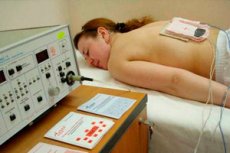
All iLive content is medically reviewed or fact checked to ensure as much factual accuracy as possible.
We have strict sourcing guidelines and only link to reputable media sites, academic research institutions and, whenever possible, medically peer reviewed studies. Note that the numbers in parentheses ([1], [2], etc.) are clickable links to these studies.
If you feel that any of our content is inaccurate, out-of-date, or otherwise questionable, please select it and press Ctrl + Enter.
Electrophoresis for bronchitis with calcium, eufillin, calcium chloride, potassium iodine
Medical expert of the article
Last reviewed: 06.07.2025

According to statistics, every third person faces bronchitis. This is an inflammatory disease of the respiratory tract, which entails breathing and blood circulation problems. To speed up the recovery process, it is necessary to approach the therapy comprehensively. Treatment of bronchitis with electrophoresis is especially effective.
Indications for the procedure
The procedure helps speed up recovery. It is important not to neglect the disease and start the procedures on time. In this case, electrophoresis will be most effective.
Electrophoresis for bronchitis is recommended for both adults and children. It will help get rid of a strong suffocating cough and improve the patient's condition. The liquefaction of phlegm and its removal from the bronchi is carried out due to the electromagnetic field, which allows drugs to penetrate the pores of tissues and enter the affected area.
Technique electrophoresis for bronchitis
Accumulating sputum leads to blockage of the bronchi, which can contribute to the development of pneumonia. Electrophoresis helps to get rid of mucus in the lumens of the bronchi. This procedure is absolutely painless and does not take much time. Due to this, the use of electrophoresis for bronchitis is allowed not only in adults, but also in children.
Once the drug particles penetrate the tissues, they are quickly carried through the bloodstream and interact with the immune system. After the procedure, the drugs remain in the body for about 2 weeks.
Only after conducting an examination and establishing a diagnosis, the doctor determines the duration of the procedures and medications. In case of residual manifestations of the disease, doctors can prescribe electrophoresis after bronchitis. Correct implementation and accuracy of the diagnosis will help to avoid undesirable consequences after the procedure.
Medicines
Doctors consider electrophoresis with calcium chloride for bronchitis to be a universal and effective method. By creating a calcium depot, the drug remains in the body longer.
During electrophoresis with calcium chloride for bronchitis, the drug enters the body, accumulates and liquefies phlegm;
A large list of drugs is also used for physiotherapy procedures, the most effective of which are:
- Electrophoresis with euphyllin for bronchitis helps to reduce blood pressure, reduces smooth muscle spasms, normalizes respiratory function, eliminates bronchospasms; See also the publication on the use of euphyllin for obstructive and chronic bronchitis in inhalations and droppers
- Electrophoresis with potassium iodine for bronchitis produces an anti-inflammatory effect, reduces cholesterol levels and slows down the growth of bacteria;
- Miramistin. Has antimicrobial and antiseptic properties, promotes the destruction of pathogenic cells.
Treatment is also carried out using a natural mineral - bischofite. It contains a large amount of iodine, iron, sodium. Electrophoresis with bischofite for bronchitis is the entry of chemical elements of the mineral into the infected body, which help improve blood circulation and tissue nutrition.
Specifics of pediatric treatment
Electrophoresis for bronchitis in children is one of the most successful methods of therapy. Since the active substances enter the body through the skin, they do not cause harm to the gastrointestinal tract.
In case of bronchitis, electrophoresis is prescribed to the chest. A cloth soaked in a medicinal preparation is placed between the skin and the plates. The child does not experience pain or other unpleasant sensations.


 [
[